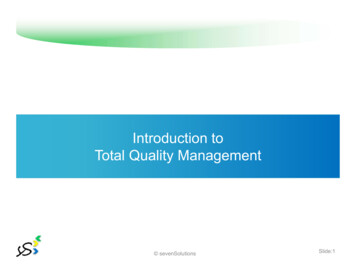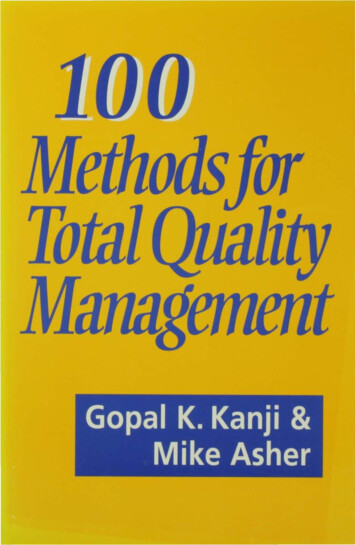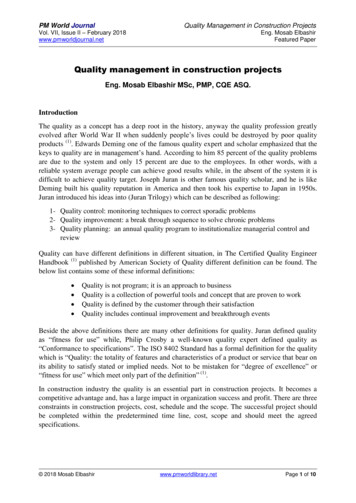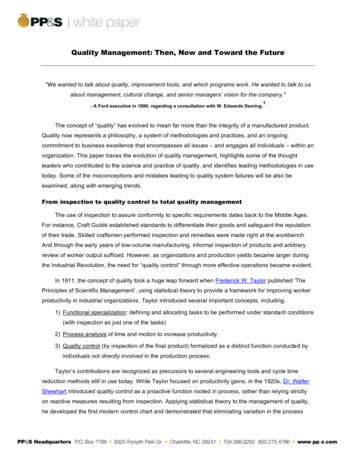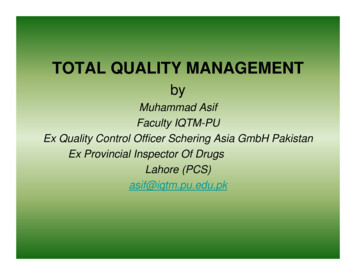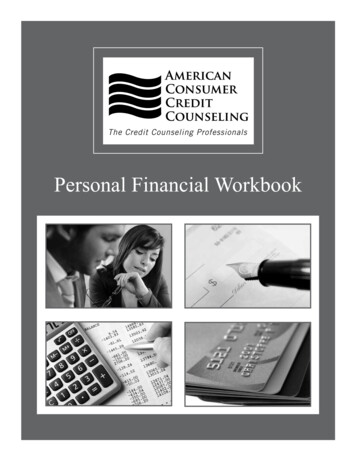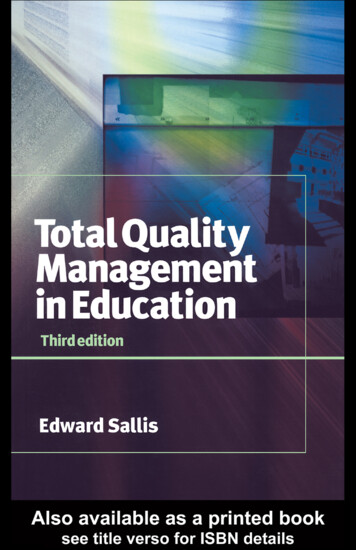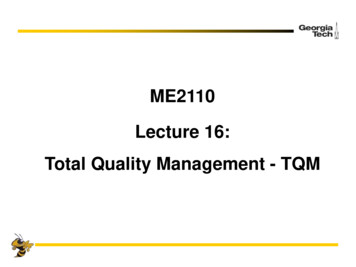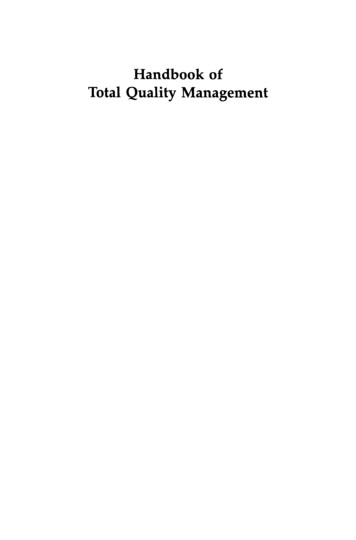
Transcription
Handbook ofTotal Quality Management
Handbook ofTotal Quality ManagementChristian N. Madu, Ph.DResearch Scholar, Professor and ChairManagement Science ProgramEditor-in-Chief, International Journal of Quality ScienceDepartment of Management and Management ScienceLubin School of BusinessPace UniversityNew York, USA., SPRINGER SCIENCE BUSINESS MEDIA, B.V.
A c.1.P. Catalogue record for this book is available from the Library of CongressISBN 978-1-4613-7409-1ISBN 978-1-4615-5281-9 (eBook)DOI 10.1007/978-1-4615-5281-9All Rights Reserved 1998 Springer Science Business Media DordrechtOriginally published by Kluwer Academic Publishers in 1998Softcover reprint ofthe hardcover lst edition 1998No part of the material protected by this copyright notice may be reproduced orutilized in any form or by any means, electronic or mechanical,inc1uding photocopying, recording or by any information storage andretrieval system, without written permission from the copyright owner.
This book is dedicated to my wifeAssumpta and our three boys Chichi, Chike and Chidi
ContentsContributorsForewordPrefaceBiographical sketchNotable quality scholarsGlossary1. Introduction to qualityChristian N. Madu2. Comparing Deming's and Juran's philosophies to theformation of total quality leaders' world viewsChu-Hua Kueixixvxviixixxxixxv1213. Strategic quality planningBin Srinidhi414. Quality improvement through learning curve analysisAdedeji B. Badiru875. Human resources and trainingAmrik Sohal and Andrea Howell6. Quality management in small and medium-sized companiesand strategic managementM. Dolores Moreno-Luzon, F.J. Peris and F.J. Santonja1081287. Developing attributes of quality for Internet applicationsChristian N. Madu1548. Strategic total quality managementChristian N. Madu1659. Accounting and capital budgeting for qualityVasanthakumar N. Bhat21310. Success in AMT implementation and quality enhancement:is there a link?Hamid Noori, John L. Michela and Shailendra Jha11. Service qualityChu-Hua Kuei225245
viiiContents12. Quality, productivity and information systemsJoak Jurison26013. Total quality management in the supply chainPaul Levy27514. Involving the supply chain in designJeffrey K. Liker and S. Nazli Wasti30415. Self-assessmentKlaus J. Zink and Andreas Schmidt32016. Process performance, appraisal and employee developmentplanningRon S. Kenett and Marc E. Maisel34417. Introduction to ISO and ISO quality standardsChristian N. Madu36518. TQEM - methods for continuous environmental improvementJohn F. Affisco38819. Benchmarking: a quest for continuous improvementInjazz J. Chen and Kenneth A. Paetsch40920. Concurrent engineeringJoseph T. Emanuel and Dennis E. Kroll42521. Reengineering and continuous improvementGeorge W Arnold and M. Hosein Fallah44622. Quality function deploymentMark A. Vonderembse and Tom Van Fossen46023. Introduction to probability and statisticsChristian N. Madu47524. Tools for quality control and process redesignNicholas C. Georgantzas50825. Statistical quality controlChristian N. Madu52826. Design of experiments: a polymer coating processNicholas Georgantzas56527. Quality engineering: loss functions, parameter design,and robust qualityShane J. Schvaneveldt and Takao Enkawa28. Reliability and maintainabilitySurendra M. Gupta593611
Contents29. Total quality management in ChinaChyau Tuan and Linda Fung-Yee NgIX62630. Total quality management in India: a tool with wideningacceptanceSurendra K. Kaushik63831. The development of national consciousness of quality:the Singapore experienceEric w.K. Tsang65032. Total quality management in EuropeTon van der Wiele and Barrie Dale33. Total quality management - implementation on the basis ofPolandEdward Kindlarski and Ben Bella Jaoko66568234. The development of total quality management in DenmarkJens J. Dahlgaard and Ove Hartz70035. Total quality in Australia and New ZealandDanny Samson71736. Quality management in developing economiesChristian N. Madu73437. Malcolm Baldrige, Deming Prize and European QualityAwards: a review and synthesisPradeep Gopalakrishna and Mahesh Chandra754AppendixIndex769781
ContributorsDr John F. Affisco, Professor of Business Computer Information Systemsand Quantitative Methods, Frank G. Zarb School of Business, HofstraUniversity, Hempstead, NY 11550, USA.Dr George W. Arnold ENGSCD, Director Standards and Intellectual Property, Lucent Technologies, Inc., Holmdel, NJ, USA.Dr Adedeji B. Badiru, Professor of Industrial Engineering and Dean ofUniversity College, University of Oklahoma, Norman, Oklahoma, USA.Dr Vasanthakumar N. Bhat, Professor of Management Science, LubinSchool of Business, Pace University, New York, USA.Dr Mahesh Chandra, Associate Professor of Computer InformationSystems and Quantitative Methods, Frank G. Zarb School of BusinessHofstra University, Hempstead, NY 11550, USA.Dr Injazz J. Chen, Associate Professor of Operations Management DBAProgram Co-ordinator, College of Business Administration, ClevelandState University, Cleveland, Ohio, USA.Dr Barrie Dale, Professor of Quality Management, Manchester School ofManagement, University of Manchester Institute of Science and Technology, Manchester, UK.Dr J. J. Dahlgaard, Professor, Research Group of Quality Management,The Aarhus School of Business, AARHUS V. Denmark.Dr Joseph T. Emanuel, IMET Department, Bradley University, Illinois,USA.Dr Takao Enkawa, Department of Industrial Engineering and Mgmt,Tokyo Institute of Technology, Tokyo, Japan.Dr M. Hosein Fallah, Product Realization Technologies, Bell Laboratories, Holmdel, NJ, USA.Dr Nicholas C. Georgantzas, Professor of Management Systems,Fordham University, Lincoln Center, New York, USA.Dr Pradeep Gopalakrishna, Professor of Marketing, Lubin School ofBusiness, Pace University, New York, USA.
xiiCon tribu torsDr Surendra M. Gupta, the Director of the Laboratory for ResponsibleManufacturing and is on the faculty of the Department of Mechanical,Industrial and Manufacturing Engineering at Northeastern University inBoston.Dr Dve Hartz, Associate Professor, Dept of Industrial Management,Technical University of Denmark, Denmark.Dr Andra Howell, Monash University, Faculty of Business and Economics, PO Box 197 Caulfield East, Melbourne, Victoria, Australia.Dr Ben Bella Jaoko, Warsaw University of Technology, Institute forOrganization of Production Systems, Faculty of Production Engineering,Quality Systems Group, Warsaw, Poland.Dr Schailendra Jha, School of Business and Economics, Wilfred LaurierUniversity, 75 University Avenue West, Waterloo, Ontario, Canada.Dr Jaak Jurison, Associate Professor and Deputy Chair, Information andCommunications Systems, Graduate School of Business Administration,Fordham University, New York, New York, USA.Dr Surendra K. Kaushik, Department of Finance and Economics, LubinSchool of Business, Pace University, One Pace Plaza, New York, NY10038, USA.Dr Ron S. Kenett, Senior Partner, Kenett-Preminger Associates, KPA LtdManagement Consulting, Representing the Juran Institute in Israel,Herzlia Pituah, IsraelProfessor Edward Kindlarski, Warsaw University of Technology, Institute for Organization of Production Systems, Faculty of ProductionEngineering, Quality Systems Group, Warsaw, PolandDr Dennis E. Kroll, IMET Department, Bradley University, Illinois,USADr Chu-Hua Kuei, Professor of Management and Management Science,Lubin School of Business, Pace University, New York, USADr Paul Levy, Centre for Research in Innovation Management, BrightonBusiness School, University of Brighton, Falmer, Brighton, UKDr Jeffrey K. Liker, Associate Professor, Industrial and Operations Engineering, University of Michigan, Ann Arbor, Michigan, USADr M.D. Moreno-Luzon, Professor of Economics and Business Studies,University of Valencia, Edificio Oriental Departamental, Valencia,Spain.Dr Christian N. Madu, Research Scholar, Professor and Program Chair,Management Science Program, Lubin School of Business, Pace University, New York, USA.
ContributorsXlllMr Marc E. Maisel, Senior Consultant, KPA Ltd Management Consulting, Representing the Juran Institute in Israel, Herzlia Pituah, Israel.Dr John L. Michela, School of Business and Economics, Wilfred LaurierUniversity, 75 University Avenue West, Waterloo, Ontario, Canada.Dr Linda Fung-Vee Ng, Professor, Department of Decision Sciences andManagerial Economics, The Chinese University of Hong Kong, Shatin,Nt, Hong Kong.Dr Hamid Noori, Professor of Technology and Operations Management,School of Business and Economics, Wilfred Laurier University, Waterloo,Ontario, Canada.Dr Kenneth A. Paetsch, Assistant Professor, Department of OperationsManagement, College of Business Administration, Cleveland State University, Cleveland, Ohio, USA.Dr F. J. Peris, Professor of Economics and Business Studies, University ofValencia, Edificio Oriental Departamental, Valencia, Spain.Dr Danny Samson, Leslie Froggatt Professor of Manufacturing Management and Director, Centre for Manufacturing Management, MelbourneBusiness School Ltd, The University of Melbourne, Carlton, Victoria,Australia.Dr F. J. Santonja, Professor of Economics and Business Studies, University of Valencia, Edificio Oriental Departamental, Valencia, Spain.Dipl.-Wirtsch.-Ing A. Schmidt, Assistant Lecturer, Industrial Management and Human Factors, University of Kaiserlautern, Kaiserlautern,Germany.Dr Shane J. Schvaneveldt, Department of Business Administration,Weber State University, Ogden, Utah, USA.Dr Amrik Sohal, Monash University, Faculty of Business and Economics, PO Box 197 Caulfield East, Melbourne, Victoria, Australia.Dr Bin Srindidhi, Associate Professor, Accounting and InformationSystems Area, Faculty of Management, Rutgers University, UniversityHeights, Newark, New Jersey, USA.Dr Eric W.K. Tsang, Lecturer, School of Accountancy and Business,Nanyang Technological University, Singapore.Dr Chyau Tuan, Professor, Department of Decision Sciences and Managerial Economics, The Chinese University of Hong Kong, Shatin, Nt,Hong Kong.Dr Ton van der Wiele, Professor of Economics, Strategic Quality Management Institute, Erasmus Universiteit Rotterdam, Rotterdam, TheNetherlands.
xivContributorsMr Tom Van Fossen, Leelanau Industries, 6052 E. Traverse Highway,Traverse City, Michigan, USA.Dr Mark A. Vonderembse, Professor of Operations Management andDirector Manufacturing Management MS and PhD Program, The University of Toledo, College of Business Administration, Toledo, Ohio,USA.Dr S. Nazli Wasti, Assistant Professor, Department of Management,Middle East Technical University, Turkey.Dr Klaus J. Zink, Professor, Chair for Industrial Management andHuman Factors, University of Kaiserlautern, Kaiserlautern, Germany.
ForewordAny handbook on a major topic will have inclusions and omissions. Thisbook contains vast comprehensive inclusions of virtually all explorationson quality management. Handled by 47 authors based in 13 differentcountries with extensive experience on world class quality management,this book is invaluable as a reference guide, class usage and professionalhelp.Quality issues have gained great importance as the business worldbecame global and firms across the many countries sought to compete inboth price and quality. Thus, product cost and quality of product orservice became the predominant determinant of market share and profit.A long-term view towards attaining market share through reputation asopposed to short-term profit making has become the rule of modernbusiness success. Certifications such as the ISO 9000 series and awardssuch as Baldrige are sought by companies as proof of the quality of theirproducts to gain entry into the world market-place. At the same time, itis recognized that world class quality requires a commitment that farexceeds what is needed to get these certificates. Thus, this Handbook,quite appropriately, discusses not only the requirement for attainingthese certificates and the rules for the awards but goes on to provide helpto compete in the global market with world class quality.Quality can be improved through continuous (Kaizen) improvementsand/ or reengineering efforts including process and design innovations.Chapters are included that describe these approaches including practicaltools for redesign, self-assessment, human resource training and benchmarking. Contributions include process performance appraisal, servicequality management and concurrent engineering. Quality concerns withrespect to productivity, information systems and advanced manufacturing technology are addressed. How quality can improve through properlearning curve analysis is explained in one article.Quality consciousness should permeate the entire value chain. Towardsthis end, there are chapters on effecting quality awareness through supplychains.A good handbook should deal with details of quality practices in variouscountries of the world. This is done thoroughly here in several chaptersfocusing on several countries of Europe and Asia. Countries detailedinclude Denmark, Poland, Australia, New Zealand, Singapore, China andIndia. This provides a good comparative perspective on practices.
xviForewordQuality studies are not useful if they are not tied to strategies forimprovement. Several chapters consider important strategies for qualityimprovement and initiation and performance evaluation through auditing. There is a separate chapter on quality deployment function which isan important strategic tool.Implementation of quality analyses and strategy can be effective onlywhen the 'how to' of quality is learned. The editor has included amplecoverage on the statistical aspects of the tools. Statistical quality control,design of experiments, Taguchi loss functions, reliability and maintainability are key topics that are covered in good detail and clarity. To aid theunprepared reader, there is a good chapter on introduction to probabilityand statistics.The editor, Professor Christian N. Madu is a well-recognized authorityon quality with numerous academic and professional publications. Asthe Editor-in-Chief of the premier quality journal International Journal ofQuality Science, he occupies an enviable position that has enabled him topersuasively summon so many experts to write for this Handbook. Thesechapters are specifically written for this book and are not just reprints ofpreviously published manuscripts. Thus, there is a cohesiveness to thetreatment of the subject. This Handbook will be very valuable to both theprofessionals who wish to consult an authoritative book on quality andthe academics and students who wish to keep up with the currentevolution on the study of quality management.Kashi R. BalachandranProfessor of Accounting and Operations ManagementStem School of BusinessNew York UniversityNew York, NY
PrefaceThe Handbook of Total Quality Management is written as an introduction tototal quality management with the intention of providing carefullyselected and high quality chapters by reputable authors in the field. Withthe growing emphasis on total quality management and the proliferationof articles in this area, it is important to carefully organize this body ofknowledge in a substantial form. Authors have emphasized both theoryand practice and have drawn from several important quality applications. To broaden the reader's view of quality, authors were selectedfrom almost all continents covering more than 12 countries and nationalities. These authors present total quality management approaches fromdifferent views. We have also included country-specific approaches toquality to illustrate the cultural dependence of quality and to demonstrate that quality can be adapted in any situation.A mix of articles from both industry and academic experts are offeredand we tried as much as possible to cover every pertinent topic in totalquality management. The Handbook therefore, promises to be an important reference manual which can be used as quick reference in industrialapplication and as a text in teaching courses or conducting seminars ontotal quality management.Each chapter is written with the reader in mind. The aim is to communicate and convey the thoughts of the author. Thus, the articles arereadable. It is inevitable that a discussion of quality management willcontain statistics. Though statistics may be hard for some readers, wehave added a chapter on the "Introduction of Probability and Statistics".This chapter hopefully, will help prepare the reader for the moreadvanced topics on statistics.The reader will find that this Handbook is very comprehensive andcontains major topics that are related to total quality management. Thecomposition of the Handbook includes all related topics in Total QualityManagement (TQM), emerging technological issues such as Internetapplications, re-engineering and concurrent engineering, statistical issuesin quality, quality standards and awards, quality management practice indifferent countries and service quality. The exposition to these topics willhelp the reader to venture into more details and advanced topics. Thereader is bound to find this Handbook to be the most comprehensivehandbook of TQM available in the market.The Handbook could not have been possible without the devotion and
XVlllPrefacecommitment of the authors. Each one of them has worked relentlessly toproduce an excellent piece. I am greatly indebted to them. Of course, noone deserves more acknowledgment than my Assistant Editor - MsKoula Kilaras whose job was to contact the authors and follow-up withall the communications and deadlines. Without her assistance this projectwould have been impossible. It is Chapman & Hall's decision to publishthis work that made the project possible. I greatly appreciate the supportthat Mark Hammond - Senior Editor - has given to this project and thefrequent communication I received for more than a year through e-mailservices from his editorial assistants Joanne Jones, Deborah Millar andAlison Provan. All these people have helped to keep up the pressure andnow here is the book. I thank my good friend Chu-Hua Kuei for hissupport through this project and his dedication to make sure that thisproject was completed on time. I also thank K.R. Balachandran of NewYork University for writing the Foreword to the Handbook. All the abovementioned have contributed in making this an excellent book that ourreaders will be proud of.Christian N. MaduPace UniversityNew York
Biographical sketchChristian N. Madu is research scholar, professor and chair of themanagement science program at the Lubin School of Business, PaceUniversity. He is the author/co-author of more than 75 research papersin several areas of operations research and management science thathave appeared in journals such as Decision Sciences, lIE Transactions,Journal of Operational Research Society, Applied Mathematics Letters, Mathematical and Computer Modeling, Long Range Planning, European Journal ofOperational Research, OMEGA, Technological Forecasting and Social Change,Socio-economic Planning Sciences, Futures, Quality Management Journal andseveral others. He is the author/co-author of seven other books including Strategic Total Quality Management (co-author Chu-Hua Kuei), Managing Green Technologies for Global Competitiveness and edited Management ofNew Technologies for Global Competitiveness. Dr Madu is also the editorin-chief of the International Journal of Quality Science and is the Presidentof the Center for Quality and Technology Management - a consultinggroup that also conducts seminars and in-house training sessions forcorporations around the world. He has served as a consultant to severalorganizations. Dr Madu can be reached through his e-mail address atChrisMadu@aol.com.
Notable quality scholarsIn this section, we briefly introduce quality scholars whose works havehad significant impact on the practice of quality.W. Edwards Deming - considered by many as the father of TQMmovement, a notable author and lecturer of statistical quality. Dr Demingis credited for having helped Japanese manufacturers improve theirquality after the Second World War. The coveted Japanese quality award- the Deming Prize - is named in his honor. Some of his contributionsinclude the System of Profound Knowledge which consists of four majorand interrelated parts: appreciation of a system, knowledge about variation, psychology of individuals, society and change; Deming's 14 points,an outline of management principles that will help to achieve qualityimprovement; Deming chain reaction, an exposition of the relationshipbetween productivity and quality and job creation; PDCA (plando-cheek-act) cycle though not developed by Deming, he popularized itsuse in planning for quality; and Red Bead Experiment used extensivelyin his lectures to illustrate why workers should not be ranked to identifythe good and bad performers since often times, the problem may be withthe system and not the worker.Dr Deming was born in Sioux, Iowa, on October 14, 1900, and grew upin Cody, Wyoming. He earned a bachelors degree in physics from theUniversity of Wyoming and a PhD in mathematical physics from YaleUniversity in 1928. He worked for the United States Department ofAgriculture where he developed a keen interest in statistical controlthrough his encounter with Dr Walter Shewhart in the mid-1920s whileworking with Western Electric Co. He also worked for the US Bureau ofthe Census and the US weapons industry. He later worked as a consultant and a Distinguished Professor in Management at ColumbiaUniversity. In 1960, he was the recipient of the Order of Sacred Treasure,2nd Class, from the Emperor of Japan. He died in 1993 at the age of 93.Joseph M. Juran - Juran and Deming are the pre-eminent championsof quality and they considerably share in both contribution to the currentquality movement and status. Juran's contributions focus on the fourareas: definitions of quality and the cost of quality, quality habit, qualitytrilogy and Universal breakthrough sequence. He defines quality as"fitness for use." This is one of the most popular definitions of qualitysince it encompasses quality of design, quality of conformance andengineering issues such as availability, safety and field use. He also
xxiiNotable quality scholarsintroduced the cost of quality in the 1951 edition of his Quality ControlHandbook. He identifies four types of cost of quality namely, internalfailure costs, external failure costs, appraisal costs and prevention costs.By exposing management to the cost of quality, they hopefully will payattention to quality improvement efforts.With 'quality habits', he insists on the need for a firm to have a focusedapproach to continuously improve quality and this should develop into ahabit of quality that will seek realistic goals and objectives. The guidelines that achieve quality improvement should be clear and managementmust take action to successfully build the quality habit.The quality trilogy involves three inseparable parts that constituteactions the firm must take to continuously improve quality. These arequality planning, quality control and quality improvement.Juran also offers the Universal breakthrough sequence which logicallyis similar to reengineering. This consists of a set of actions managementmust take to make a major leap in quality. This involves general actionsthat are applicable to any organization problem. According to Juran,breakthroughs follow a universal sequence and that sequence involvesthe following: proof of need, project identification, organizing forimprovement, diagnostic journey, remedial action, resistance to changeand holding onto gains.Juran like Deming was exposed to statistical quality control by DrWalter Shewhart at about the same time. He was born on 24 December,1904 in Braila, Romania and grew up in Minneapolis, Minnesota. Hereceived a bachelor of science in electrical engineering from the University of Minnesota in 1924 and a JD from Loyola in 1935. In 1981, hewas recipient of the Order of Sacred Treasure, 2nd Class, from theEmperor of Japan. He currently serves as the Chairman emeritus, JuranInstitute Inc., in Wilton, Connecticut.Harold F. Dodge - is known for his contributions to statistical qualitycontrol. In collaboration with Harry. G. Romig, he developed acceptancesampling plans that are widely used for product inspections. Theseacceptance sampling plans are widely known as Dodge-Romig samplingplans. In 1940, they published acceptance sampling tables for four different types of sampling namely: single-sampling lot tolerance tables,double-sampling lot tolerance tables, simple-sampling average outgoingquality limit tables and double-sampling average outgoing quality limittables. He was also instrumental in developing important acceptancesampling concepts such as consumer's risk, producer's risk, operatingcharacteristic curve and average outgoing quality level.Harry G. Romig - in addition to the work he did with Harold F.Dodge regarding acceptance sampling procedures (see Harold F. Dodge),he developed the first sampling plans using variable data. He alsodeveloped the concept of average outgoing quality limit.Philip B. Crosby - Crosby is an advocate of zero defects. According to
Notable quality scholarsxxiiihim, quality is free in the long run. He also introduced the ManagementMaturity Grid to assess management and its current position on quality.This Grid can help redirect future organizational emphasis on quality.He offered 14 steps for quality improvement that can be used to implement the Management Maturity Grid. His contention that zerodefect can be achieved and that quality is free have generated a lot ofdebate.Kaoru Ishikawa - a well respected Japanese professor of management.He introduced the cause-effect diagram also known as the fishbone orIshikawa diagram. This diagram classifies problems in four places:methods, manpower, material and machines or what is known as the4Ms. Potential quality problems can be identified and analysed. Ishikawaalso introduced quality circles. Quality circles are gradually beingreplaced by teams primarily because teams are empowered while qualitycircles are not.Shiego Shingo - Shiego Shingo is a co-developer of the inventorymanagement technique known as just-in-time system. Mr Shingo fromJapan is known in Japan as Mr Improvement. He introduced what is nowknown as Fail-Safe design or the Shingo System. This method is based onusing source inspection and the poka-yoke system to achieve zerodefects. Shingo argues that statistical quality control methods provideafter the fact information and do not prevent defects. He argues thatchecks must be introduced along the process to prevent defects. Thisinvolves three steps: successive check inspection, self-check and sourceinspection.Yoji Akao - a well respected professor from Japan, Professor Akaointroduced the quality function deployment (QFD). In the West, QFD ispopularly known as the 'House of Quality'. QFD offers an importantway for corporations to understand the needs and wants of their customers. It also offers the opportunity for benchmarking with world classleaders.Masaaki Imai - brought to light in the West, the practice of continuousimprovement in Japan or what is often referred to as the principles ofKaizen in Japan. Japanese industrial successes are often attributed toKaizen which calls for small incremental improvements in a process.Continuous improvement is often times synonymous to total qualitymanagement.Genichi Taguchi - a Japanese statistical consultant, revolutionalizedthe applications of statistics to quality and redefined quality. In hisviews, products should be robust enough to withstand variations thatmay result from environmental and production factors. His methods arebased on the efficient use of experimental designs. Although his experimental design procedures are similar to standard design methods, he,however, offered tables and graphs (linear graphs) that made it easier forpractitioners to use. His other major contribution is in his definition of
xxivNotable quality scholarsquality using a quality loss function (QLF). He defines QLF as a loss tosociety for producing inferior products. QLF measures the cost of qualityby looking at variations from the target value or specification.George P. Box - is a well respected professor of statistics in the UnitedStates. He is well known for his contributions on statistical design ofexperiments.Walter A. Shewhart - is regarded by many as the father of statisticalquality control. He is credited with having introduced both W. EdwardsDeming and Joseph M. Juran to statistical quality control. He developedthe statistical control charts and defined two types of causes of variation:natural and special causes of variation. Also, he introduced the plando-study-act (PDSA) cycle which is often referred to as the Shewhartcycle. Dr Deming renamed the PDSA cycle the PDCA cycle with Creferring to check replacing the S for study.Armand V. Feigenbaum - is one of the leading advocates of totalquality control. In fact, the term 'total quality control' as popularly usedin Japan and known as 'total quality management' in the US and most ofEurope, was the title of his 1951 book. He originated this concept and hascontributed significantly to the TQM movement through his writing andconsulting work. He is the founder and president of General Systems Co.Michael Hammer - is known for his pioneering work on reengineering. According to Hammer and Champy in their 1993 book,re-engineering is defined as 'the fundamental re-thinking and radicaldesign of business processes to achieve dramatic improvement in critical,contemporary measures of performance, such as cost, quality, serviceand speed'. This contrasts with continuous improvement which seeks forgradual and incremental improvements over time.
GlossaryAcceptable quality level (AQL) Minimum number of defectives that will becontained in a lot before the lot is accepte
18. TQEM - methods for continuous environmental improvement 388 John F. Affisco 19. Benchmarking: a quest for continuous improvement 409 Injazz J. Chen and Kenneth A. Paetsch 20. Concurrent engineering 425 Joseph T. Emanuel and Dennis E. Kroll 21. Reengineering and continuous improvem
